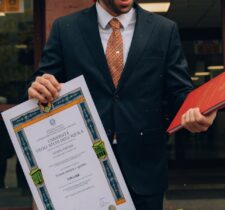Are you legally authorized to work in the United States? This is a critical question for anyone seeking employment as a foreign national. Understanding the legal requirements for work authorization is essential to ensure compliance with U.S. laws and to avoid potential legal issues. Whether you’re an international student, a skilled worker, or an employer looking to hire foreign talent, knowing the different types of work visas and permits can help you navigate the complexities of U.S. immigration and employment laws.
In this article, we will explore what it means to be legally authorized to work in the U.S., the differences between work visas and permits, and the steps to obtain the proper employment documentation.
What Does It Mean to Be Legally Authorized to Work in the United States?
Being legally authorized to work in the United States means that you have the necessary documentation that permits you to be employed by a U.S. employer. This authorization applies not only to U.S. citizens and permanent residents but also to non-citizens who have obtained the appropriate work visas or permits.
Without proper authorization, working in the U.S. can lead to severe legal consequences for both the employee and the employer. Therefore, understanding how to get authorized and the types of documentation available is crucial.
Understanding Work Visas vs. Work Permits
What Is a Work Visa?
A work visa is a type of legal document that allows non-U.S. citizens to enter the country for employment purposes. Unlike tourist visas, work visas permit individuals to work for a specific employer for a designated period. Different types of work visas cater to various employment needs, from temporary seasonal jobs to long-term professional positions.
Examples of common work visas include:
- H-1B Visa: For skilled professionals in specialty occupations.
- L-1 Visa: For intracompany transferees.
- O-1 Visa: For individuals with extraordinary abilities or achievements.
What Is a Work Permit (Employment Authorization Document – EAD)?
A work permit, or Employment Authorization Document (EAD), is a card issued by the U.S. Citizenship and Immigration Services (USCIS) that grants non-citizens the right to work in the United States. Unlike work visas, EADs are not tied to a specific employer, offering more flexibility for the worker. Common recipients include asylum seekers, refugees, and certain categories of visa holders.
Types of Work Visas in the United States
Temporary (Non-Immigrant) Work Visas
Temporary work visas allow foreign nationals to work in the U.S. for a limited period. Each visa type has specific requirements and restrictions, often tied to a particular job or employer.
Some examples include:
- H-1B Visa: For professionals with a higher education degree or its equivalent.
- H-2A Visa: For temporary agricultural workers.
- H-2B Visa: For temporary non-agricultural workers.
- L-1 Visa: For employees of international companies being transferred to a U.S. office.
- O-1 Visa: For individuals with extraordinary abilities in arts, sciences, business, or athletics.
Permanent (Immigrant) Work Visas
Permanent work visas, often leading to a Green Card, allow individuals to work and live in the U.S. permanently. These are also known as employment-based immigrant visas.
Categories include:
- EB-1: For individuals with extraordinary ability, outstanding professors, or multinational executives.
- EB-2: For professionals with advanced degrees or exceptional abilities.
- EB-3: For skilled workers, professionals, and other qualified workers.
How to Obtain Work Authorization in the United States
Steps to Apply for a Work Visa
Applying for a work visa involves several steps and can vary depending on the type of visa:
- Find a U.S. Employer Sponsor: Most work visas require a U.S. employer to sponsor the application.
- File a Petition with USCIS: The employer must submit a petition (such as Form I-129 for H-1B) to the USCIS.
- Attend a Visa Interview: Once the petition is approved, the applicant may need to schedule an interview at a U.S. consulate or embassy.
- Submit Required Documents: Proof of identity, education, and employment offer are typically needed.
- Wait for Approval: After approval, the applicant can travel to the U.S. to begin work.
How to Apply for a Work Permit (EAD)
If eligible, applying for an EAD involves the following:
- Complete Form I-765: This is the Application for Employment Authorization.
- Submit Supporting Documents: Include identification, visa status proof, and photographs.
- Pay the Application Fee: Fees may vary depending on the category.
- Receive EAD Card: If approved, the EAD card will be mailed, permitting the holder to work.
Who Needs to Be Legally Authorized to Work in the United States?
All foreign nationals, including international students and visitors, must have the appropriate authorization to work in the U.S. This includes various categories of individuals:
- International Students: Those on F-1 visas may work under specific conditions, such as Optional Practical Training (OPT) or Curricular Practical Training (CPT).
- Temporary Visitors: Those on temporary visas must have a work permit to legally engage in employment.
- Permanent Residents: Holders of Green Cards are already authorized to work.
Consequences of Working Without Authorization
Working without proper authorization can lead to severe legal consequences, including deportation for the individual and fines or penalties for the employer. Unauthorized work also disqualifies individuals from future visa benefits and can lead to a ban on entering the U.S. in the future.
Rights and Protections for Authorized Workers in the United States
Legally authorized workers, including non-citizens, are entitled to various rights under U.S. labor laws, such as:
- Fair Wages: The right to receive minimum wage and overtime pay.
- Safe Working Conditions: Protection from unsafe work environments.
- Non-Discrimination: Protection against discrimination based on race, nationality, or gender.
Conclusion
Understanding whether you are legally authorized to work in the United States is crucial for anyone seeking employment as a foreign national. Navigating the complexities of work visas and permits can be challenging, but with the correct information and proper documentation, you can ensure a smooth and legal transition to employment. Always consult legal professionals if you are unsure about your eligibility or require help with the application process.
FAQ’s
Q1: What documents do I need to prove I am authorized to work in the U.S.?
- You may need a valid work visa, an Employment Authorization Document (EAD), or a Green Card to prove your work authorization.
Q2: Can international students work in the U.S.?
- Yes, students on F-1 visas can work under specific programs like OPT or CPT, but restrictions apply.
Q3: What happens if I lose my work authorization?
- If your work permit expires or is revoked, you must stop working immediately and may need to apply for a renewal or new authorization.
Q4: Can I apply for a work permit while on a tourist visa?
- No, tourist visas do not allow employment in the U.S. You must apply for a proper work visa or permit before seeking employment.








